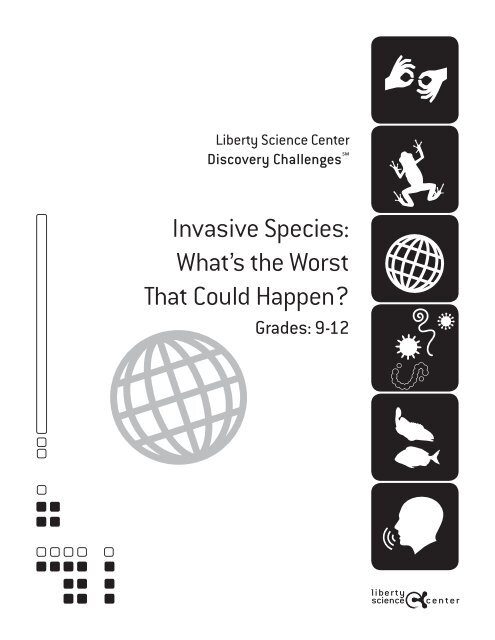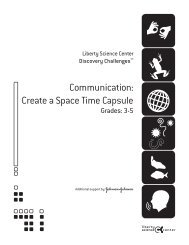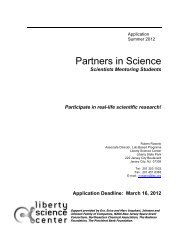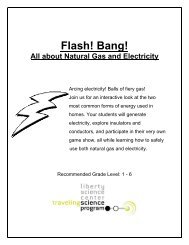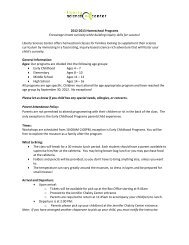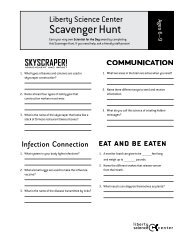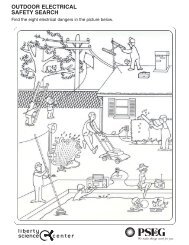Invasive Species- What's the worst that could happen? – Grades 9-12
Invasive Species- What's the worst that could happen? – Grades 9-12
Invasive Species- What's the worst that could happen? – Grades 9-12
Create successful ePaper yourself
Turn your PDF publications into a flip-book with our unique Google optimized e-Paper software.
Liberty Science Center<br />
Discovery Challenges ◊<br />
<strong>Invasive</strong> <strong>Species</strong>:<br />
What’s <strong>the</strong> Worst<br />
That Could Happen?<br />
<strong>Grades</strong>: 9-<strong>12</strong>
The stability of ecosystems can be a precarious balance, especially when<br />
<strong>the</strong>re are changes in species diversity and population dynamics. <strong>Invasive</strong><br />
species are a major concern in many ecosystems within <strong>the</strong> United States<br />
and <strong>the</strong> prevention and eradication of invasives has become a hot topic<br />
in conservation. In this Discovery Challenge students will explore local<br />
ecosystems and introductory pathways for invasives in <strong>the</strong> Our Hudson Home<br />
gallery. In <strong>the</strong> Eat and Be Eaten gallery students will learn about species<br />
interdependence and adaptations. Then, using what <strong>the</strong>y learned in <strong>the</strong> two<br />
galleries, students will be asked to consider a <strong>worst</strong> case scenario invasion into<br />
a Hudson River ecosystem. Use this challenge to teach your students about<br />
ecosystem ecology and human impacts on <strong>the</strong> environment.<br />
Table of Contents<br />
Teacher Overview............................................................................................................. 3<br />
Curriculum Standards Alignment................................................................................ 4<br />
Your Challenge ................................................................................................................. 5<br />
Pre-Visit Lesson............................................................................................................ 6-7<br />
Post-Visit Wrap-Up....................................................................................................... 8-9<br />
Resources........................................................................................................................10<br />
Exhibit Challenge Booklet (For Students)................................................11-22<br />
• Your Challenge/We Suggest........................................................................... <strong>12</strong>-13<br />
• Exhibit Challenges........................................................................................... 14-22<br />
2<br />
Discovery Challenges <strong>Invasive</strong> <strong>Species</strong>: <strong>Grades</strong> 9-<strong>12</strong>
Teacher Overview<br />
What is a Discovery Challenge ◊ ?<br />
A Discovery Challenge:<br />
• Forges connections between Liberty Science Center’s exhibitions and what is being studied in<br />
<strong>the</strong> classroom.<br />
• Focuses and leverages student learning during visits.<br />
• Encourages inquiry and critical thinking.<br />
• Is aligned to national, New Jersey and New York science standards.<br />
Before Your Visit:<br />
• Complete <strong>the</strong> pre-visit lesson with your class to get students primed and ready for what <strong>the</strong>y<br />
will discover at Liberty Science Center.<br />
• Copy <strong>the</strong> Exhibit Challenge Booklet and distribute <strong>the</strong>m to your students and chaperones.<br />
During Your Visit:<br />
• Encourage students to visit at least three or four exhibitions to help structure <strong>the</strong>ir exploration.<br />
Students should record observations by both writing and drawing in <strong>the</strong>ir booklets.<br />
After Your Visit:<br />
• Complete <strong>the</strong> post-visit wrap-up with students to foster continued discussion and discovery<br />
back in <strong>the</strong> classroom. Career Quest extensions can be used to introduce students to career<br />
possibilities stemming from <strong>the</strong>ir favorite exhibitions.<br />
• Use <strong>the</strong> suggested list of resources to design additional relevant and engaging learning<br />
experiences for your students.<br />
Technology Tie-Ins<br />
Look for SNSE Spots!—SNSE (Science Now, Science Everywhere) allows you to<br />
use your phone to get extra information about exhibitions while on site and also<br />
allows you to learn more about <strong>the</strong> exhibitions you enjoyed after your visit.<br />
Major funding provided by National Science Foundation<br />
Liberty Science Center Discovery Challenges are available on our website<br />
at www.lsc.org/discoverychallenges.<br />
Discovery Challenges <strong>Invasive</strong> <strong>Species</strong>: <strong>Grades</strong> 9-<strong>12</strong> 3
Curriculum Standards Alignment<br />
Topic: <strong>Invasive</strong> <strong>Species</strong>: What’s <strong>the</strong> Worst That Could Happen?<br />
Grade Levels: 9-<strong>12</strong><br />
NEW JERSEY <strong>–</strong> Core Curriculum Content<br />
Standards<br />
English Language Arts:<br />
3.1. Reading<br />
3.2. Writing<br />
3.3. Speaking<br />
3.4. Listening<br />
3.5. Viewing and Literacy<br />
Social Studies:<br />
6.1.B. U.S. History, Geography, People and<br />
Environment<br />
6.1.C. U.S. History, Economics, Innovation<br />
and Technology<br />
6.3.B. Active Citizenship, Geography,<br />
People and Environment<br />
6.3.C. Active Citizenship, Economics,<br />
Innovation and Technology<br />
Technology:<br />
8.1. Educational Technology<br />
8.2. Technology Education, Engineering and<br />
Design<br />
NEW JERSEY <strong>–</strong> Core Curriculum Content<br />
Standards for Science<br />
5.1. Science Practices<br />
5.1.A. Understand Scientific Explanations<br />
5.1.B. Generate Scientific Evidence through<br />
Active Investigations<br />
5.1.C. Reflect on Scientific Knowledge<br />
5.1.D. Participate Productively in Science<br />
5.3. Life Science<br />
5.3.C. Interdependence<br />
5.3.E. Evolution and Diversity<br />
NEW YORK <strong>–</strong> Ma<strong>the</strong>matics, Science and<br />
Technology Education<br />
1 - Ma<strong>the</strong>matical analysis, scientific<br />
inquiry, engineering design<br />
2 - Using appropriate technology<br />
4 - Science: integration and application<br />
6 - Relationships and common <strong>the</strong>mes<br />
7 - Problem solving in <strong>the</strong> real world<br />
21st Century Life and Careers:<br />
9.1. 21st Century Life and Careers<br />
9.3. Awareness, Exploration and<br />
Preparation<br />
9.4. Career and Technical Education<br />
4<br />
Discovery Challenges <strong>Invasive</strong> <strong>Species</strong>: <strong>Grades</strong> 9-<strong>12</strong>
Your Challenge:<br />
What’s <strong>the</strong> Worst That Could Happen?<br />
In this Discovery Challenge, students will explore <strong>the</strong> concepts of species survival and<br />
adaption. They will relate <strong>the</strong>se traits to ecosystem diversity and stability. A healthy<br />
ecosystem has many interdependent species <strong>that</strong> live in a dynamic balance, and invasive<br />
species can disrupt this delicate balance. <strong>Invasive</strong> species are defined as organisms <strong>that</strong> are<br />
introduced from o<strong>the</strong>r ecosystems (<strong>the</strong>refore, <strong>the</strong>y are sometimes called aliens or exotics),<br />
reproduce quickly, and cause harm to <strong>the</strong> new ecosystem in some way.<br />
Based on students’ understanding of ecosystem stability, <strong>the</strong>y are asked to invent a <strong>worst</strong><br />
case invasive species scenario for a local ecosystem and write a report to present to local<br />
lawmakers. Students should pick an ecosystem in <strong>the</strong> Hudson River Estuary or be assigned<br />
one. Examples include freshwater marsh, saltwater harbor, or upland tree stands. Their<br />
species can be imaginary, so encourage students to be as creative as possible when thinking<br />
about <strong>the</strong>ir report.<br />
Finished reports should answer:<br />
• What type of organism is it?<br />
• What specific adaptations does this organism have to compete with native species?<br />
• Where did it originally come from?<br />
• How was it introduced to this region?<br />
• What impacts will this species have on a local ecosystem?<br />
• What prevention and control methods can be employed against <strong>the</strong> invasion?<br />
In addition to <strong>the</strong>ir report, have students give brief oral presentations to <strong>the</strong> class about <strong>the</strong>ir<br />
scenario and explain why lawmakers should be concerned about <strong>the</strong> species as <strong>the</strong> greatest<br />
threat to a local ecosystem.<br />
Discovery Challenges <strong>Invasive</strong> <strong>Species</strong>: <strong>Grades</strong> 9-<strong>12</strong> 5
Pre-Visit Lesson:<br />
Adaptation Interactive Game<br />
Objectives<br />
Students will be able to:<br />
• Understand <strong>the</strong> interdependence of species in an ecosystem<br />
• Recognize <strong>the</strong> evolutionary pressures one species can exert on ano<strong>the</strong>r<br />
• Realize how changes in environment will change evolutionary pressures and an organism’s<br />
survival rate<br />
Materials<br />
• Blank paper<br />
• Something to write with<br />
• A good imagination<br />
Procedure<br />
Have students imagine <strong>that</strong> <strong>the</strong>y are each a striped bass living in an undisturbed estuary (no<br />
human influences). The “school” will be migrating to <strong>the</strong> Hudson River Estuary and needs to<br />
prepare for any changes <strong>the</strong>y’ll experience in <strong>the</strong>ir new home.<br />
• Randomly assign each student in a group a different role of <strong>the</strong> following: Plant 1, Plant 2,<br />
Animal 1, Animal 2, Fungus 1. (Note: If <strong>the</strong>re are extra students in a group, assign <strong>the</strong>m a<br />
role of Fungus 2, Plant 3, etc.)<br />
• Students should choose an organism from <strong>the</strong>ir category and clearly write <strong>the</strong>ir organism<br />
(i.e. Plant 1 decides to be a grassy weed) across <strong>the</strong> top of <strong>the</strong>ir blank paper. Divide<br />
<strong>the</strong> paper into two columns, one labeled Defensive Traits, <strong>the</strong> o<strong>the</strong>r labeled Progressive<br />
Adaptations.<br />
• Round one will consist of students looking at <strong>the</strong> organism of <strong>the</strong> student sitting to <strong>the</strong>ir<br />
right and deciding on one adaptive trait <strong>the</strong>y <strong>could</strong> have <strong>that</strong> would best allow <strong>the</strong>m to take<br />
advantage of <strong>that</strong> o<strong>the</strong>r organism. This <strong>could</strong> mean a predator/prey relationship, or something<br />
else (i.e. as a plant I <strong>could</strong> decide to have sticky seeds <strong>that</strong> will be spread by <strong>the</strong> animal to<br />
my right). Encourage students to be creative, but specific in response to <strong>the</strong>ir ecosystem.<br />
Students are to privately write down <strong>the</strong>ir adaptive trait in <strong>the</strong> Progressive Adaptations column<br />
and reveal it to each o<strong>the</strong>r as a group.<br />
• In round two, students will add a trait to <strong>the</strong>ir Defensive Trait column to counteract <strong>the</strong><br />
progressive trait of <strong>the</strong> organism to <strong>the</strong>ir left (i.e. as a plant I am being eaten by <strong>the</strong> animal to<br />
my left, so I might develop a bad taste).<br />
6 Discovery Challenges <strong>Invasive</strong> <strong>Species</strong>: <strong>Grades</strong> 9-<strong>12</strong>
• Continue alternating between adding progressive adaptations toward <strong>the</strong> organism to <strong>the</strong> right<br />
and defensive traits against <strong>the</strong> organism to <strong>the</strong> left. Each group will develop into specialized<br />
ecosystems with organisms well adapted to <strong>the</strong>ir neighbors.<br />
• When students have a list of several adaptive traits in both columns, choose one student from<br />
each group and make <strong>the</strong>m move to a new group. Every “ecosystem” will have one organism<br />
removed and transplanted to ano<strong>the</strong>r group and a new organism from ano<strong>the</strong>r “ecosystem”<br />
added to <strong>the</strong> group.<br />
• Have <strong>the</strong> groups decide whe<strong>the</strong>r <strong>the</strong> traits of <strong>the</strong> transplanted organism will allow it to survive or<br />
die out in its new home. Students should also discuss what o<strong>the</strong>r factors (such as climate) might<br />
impact <strong>the</strong> survival of <strong>the</strong> transplanted species. If <strong>the</strong> organism can survive, are <strong>the</strong>re organisms<br />
in <strong>the</strong> new ecosystem <strong>that</strong> can keep its population in check, or <strong>could</strong> this become an invasive<br />
species <strong>that</strong> reproduces quickly? Would this introduced species have a harmful impact on <strong>the</strong><br />
ecosystem? What would <strong>happen</strong> to <strong>the</strong> o<strong>the</strong>r organisms in <strong>the</strong> ecosystem? Would <strong>the</strong>y have to<br />
adapt to <strong>the</strong> loss of a species and <strong>the</strong> introduction of a new one?<br />
Extensions<br />
• Volunteer as a class to monitor and eradicate invasive species in your area. Often conservation<br />
groups will have weekend outings to remove invasive plants from specific ecosystems. To<br />
find programs in your area visit http://www.invasivespeciesinfo.gov/news/whatyou.shtml. Be<br />
prepared to get dirty!<br />
• Research native plant species and encourage your school and public areas to landscape only<br />
with native species to provide more habitat for local animals. Write letters to government<br />
officials advocating “xeriscaping” and volunteer in planting efforts.<br />
• Research invasive species in your area, <strong>the</strong> ecosystems <strong>the</strong>y came from, <strong>the</strong> method of <strong>the</strong>ir<br />
introduction, and <strong>the</strong> impact on your local environment.<br />
• Educate <strong>the</strong> public! Teach o<strong>the</strong>rs in your community what invasive species threaten your<br />
community. How can people identify <strong>the</strong> species? What should <strong>the</strong>y do if <strong>the</strong>y find it? How<br />
can <strong>the</strong>y help prevent <strong>the</strong> spread?<br />
• Research which species were introduced to environments in <strong>the</strong> United States from ship<br />
ballast water. What measures has <strong>the</strong> United States enacted to prevent fur<strong>the</strong>r introductions<br />
from occurring?<br />
Discovery Challenges <strong>Invasive</strong> <strong>Species</strong>: <strong>Grades</strong> 9-<strong>12</strong> 7
Post-Visit Wrap-Up: Present Your Case!<br />
Discussion of Findings<br />
Encouraging students to communicate observations in <strong>the</strong>ir own words is key to developing<br />
understanding. After your visit, bring students toge<strong>the</strong>r so <strong>the</strong>y can share what <strong>the</strong>y discovered<br />
(observations, notes, drawings) while exploring Liberty Science Center’s exhibitions.<br />
Development of Projects<br />
Using what <strong>the</strong>y learned in <strong>the</strong> exhibitions, students will create a report on <strong>the</strong> potential threat<br />
of an invasive species to a Hudson River ecosystem. They will describe <strong>the</strong> <strong>worst</strong> case scenario<br />
of <strong>the</strong> introduction of this species into <strong>the</strong> ecosystem. They should include in <strong>the</strong>ir report <strong>the</strong><br />
characteristics and <strong>the</strong> type of organism <strong>that</strong> <strong>the</strong>y think poses <strong>the</strong> greatest risk, <strong>the</strong> impact this<br />
organism would have on <strong>the</strong> ecosystem, how <strong>the</strong>y would prevent <strong>the</strong> introduction of <strong>the</strong> species<br />
into a Hudson River ecosystem, and <strong>the</strong>ir plan to control <strong>the</strong> spread of this species should it gain<br />
a foothold in <strong>the</strong> region. This activity can be expanded by having students present a brief of <strong>the</strong>ir<br />
report to <strong>the</strong> class.<br />
Presentation of Projects<br />
Provide students with time to share <strong>the</strong>ir briefs with <strong>the</strong> class.<br />
Extensions<br />
To extend learning across <strong>the</strong> curriculum, students can:<br />
• Produce materials to educate <strong>the</strong> public about how to prevent <strong>the</strong> introduction of <strong>the</strong>ir invasive<br />
species, or how to slow spread if <strong>the</strong>ir species once it is introduced. A drawing or picture of<br />
<strong>the</strong> species should be included so <strong>that</strong> people can easily identify it. Materials might include<br />
posters, pamphlets or public service announcements.<br />
8<br />
Discovery Challenges <strong>Invasive</strong> <strong>Species</strong>: <strong>Grades</strong> 9-<strong>12</strong>
Career Quest<br />
Here are some suggestions about exposing students to careers related to this<br />
Discovery Challenge:<br />
• Have students share <strong>the</strong> different careers <strong>the</strong>y learned about while exploring Liberty Science<br />
Center’s exhibitions.<br />
• Allow students to use <strong>the</strong> internet to research <strong>the</strong>se and o<strong>the</strong>r careers related to this<br />
Discovery Challenge, including what <strong>the</strong> jobs entail, <strong>the</strong> education and special skills needed,<br />
and where someone would work in this capacity.<br />
• Invite a guest speaker/parent/guardian to come in and share his or her related career<br />
experiences. Some examples include biologists, park rangers, conservationists, employees<br />
of <strong>the</strong> U.S. Department of Agriculture, <strong>the</strong> U.S. Fish and Wildlife Service, or <strong>the</strong> New Jersey<br />
Natural Conservation Service.<br />
Discovery Challenges <strong>Invasive</strong> <strong>Species</strong>: <strong>Grades</strong> 9-<strong>12</strong> 9
Resources<br />
Liberty Science Center Programs<br />
For more information about Liberty Science Center’s exciting educational offerings<br />
please visit www.lsc.org.<br />
Websites<br />
New Jersey State <strong>Invasive</strong> <strong>Species</strong> Resources (USDA)<br />
http://www.invasivespeciesinfo.gov/unitedstates/nj.shtml<br />
River Keeper<br />
http://www.riverkeeper.org/<br />
New Jersey Dept. of Fish and Wildlife<br />
http://www.state.nj.us/dep/fgw/<br />
New York Department of Environmental Conservation: Nuisance and <strong>Invasive</strong> <strong>Species</strong><br />
http://www.dec.ny.gov/animals/265.html<br />
Preparing Your Booklets<br />
1. Remove <strong>the</strong> next <strong>12</strong> pages from<br />
this packet. DO NOT re-arrange <strong>the</strong><br />
placement or order of <strong>the</strong>se pages.<br />
2. Photocopy <strong>the</strong> pages so <strong>the</strong>y are<br />
double-sided. Make as many<br />
copies as you need.<br />
3. Fold each booklet in half.<br />
4. Give one booklet to each student<br />
and chaperone in your group.<br />
10<br />
Discovery Challenges <strong>Invasive</strong> <strong>Species</strong>: <strong>Grades</strong> 9-<strong>12</strong>
Liberty Science Center<br />
Liberty State Park<br />
222 Jersey City Boulevard<br />
Jersey City, New Jersey 07305 USA<br />
201.200.1000<br />
www.lsc.org<br />
Liberty Science Center<br />
Discovery Challenges ◊<br />
<strong>Invasive</strong> <strong>Species</strong>:<br />
What’s <strong>the</strong> Worst<br />
That Could Happen?<br />
<strong>Grades</strong>: 9-<strong>12</strong>
Notes<br />
Exhibit Challenge Booklet<br />
Your Challenge:<br />
<strong>Invasive</strong> <strong>Species</strong>: What’s <strong>the</strong> Worst<br />
That Could Happen?<br />
You are a government official who has been asked to write a report<br />
describing <strong>the</strong> <strong>worst</strong> case scenario for a potential invasive species<br />
in a Hudson River ecosystem. <strong>Invasive</strong> species are organisms not<br />
native to an ecosystem <strong>that</strong> reproduce quickly <strong>the</strong>re and cause harm<br />
to <strong>the</strong> new ecosystem. Because <strong>the</strong>y are from ano<strong>the</strong>r ecosystem,<br />
invasive species are sometimes called aliens or exotics. This report<br />
is to be presented to local lawmakers to make <strong>the</strong>m aware of <strong>the</strong><br />
dangers invasive species pose to this region.<br />
First identify <strong>the</strong> characteristics and <strong>the</strong> type of organism <strong>that</strong><br />
you feel poses <strong>the</strong> greatest risk. What region of <strong>the</strong> world would<br />
this species originate from? How would it get to <strong>the</strong> Hudson<br />
River Estuary? In <strong>the</strong> <strong>worst</strong> case scenario, what impact would<br />
this organism have on <strong>the</strong> native ecosystem? Your report should<br />
recommend how to prevent <strong>the</strong> introduction of <strong>the</strong> species into a<br />
Hudson River ecosystem. Also, you must create a plan to control <strong>the</strong><br />
spread of your species should it gain a foothold in <strong>the</strong> region.<br />
Sketch Pad<br />
2 Discovery Challenges <strong>Invasive</strong> <strong>Species</strong>: <strong>Grades</strong> 9-<strong>12</strong> Discovery Challenges <strong>Invasive</strong> <strong>Species</strong>: <strong>Grades</strong> 9-<strong>12</strong><br />
23
Notes<br />
We Suggest:<br />
✔ Visit at least three of <strong>the</strong> Exhibit Challenge locations.<br />
If one is unavailable, move on to ano<strong>the</strong>r.<br />
✔ Use <strong>the</strong> booklets to record your observations and<br />
create drawings of what you see.<br />
Sketch Pad<br />
✔ Think about how you can apply what you have<br />
learned to your challenge project.<br />
22 Discovery Challenges <strong>Invasive</strong> <strong>Species</strong>: <strong>Grades</strong> 9-<strong>12</strong> Discovery Challenges <strong>Invasive</strong> <strong>Species</strong>: <strong>Grades</strong> 9-<strong>12</strong><br />
3
1. Eat and Be Eaten Notes<br />
Where to Go<br />
Third Floor, Eat and Be Eaten, Masters of Disguise/Prickly Stick Insects<br />
and Vietnamese Stick Insects<br />
What to Do<br />
• Read <strong>the</strong> Masters of Disguise panel and observe <strong>the</strong> Prickly Stick<br />
Insects and Vietnamese Stick Insects. Compare and contrast <strong>the</strong><br />
camouflage of <strong>the</strong> Prickly Stick Insects to <strong>the</strong> Vietnamese Stick Insects.<br />
Consider This<br />
• What would <strong>happen</strong> if <strong>the</strong> habitat of <strong>the</strong> stick insects were to change?<br />
• Is one of <strong>the</strong> stick insects more specialized than <strong>the</strong> o<strong>the</strong>r? If so, how?<br />
• Would <strong>the</strong>se insects be affected more by an invasive plant or an<br />
invasive animal?<br />
• Which insect would be more sensitive to changes in <strong>the</strong>ir environment<br />
and why?<br />
Sketch Pad<br />
O<strong>the</strong>r Things to Try<br />
• Observe o<strong>the</strong>r animals in <strong>the</strong> gallery <strong>that</strong> use camouflage. Document<br />
what <strong>the</strong>se animals blend in with and which you think might be<br />
more sensitive to environmental changes. Are <strong>the</strong>re any similarities<br />
between <strong>the</strong> organisms you think are most sensitive to change?<br />
4 Discovery Challenges <strong>Invasive</strong> <strong>Species</strong>: <strong>Grades</strong> 9-<strong>12</strong> Discovery Challenges <strong>Invasive</strong> <strong>Species</strong>: <strong>Grades</strong> 9-<strong>12</strong><br />
21
Notes<br />
Notes<br />
Sketch Pad<br />
Sketch Pad<br />
20 Discovery Challenges <strong>Invasive</strong> <strong>Species</strong>: <strong>Grades</strong> 9-<strong>12</strong> Discovery Challenges <strong>Invasive</strong> <strong>Species</strong>: <strong>Grades</strong> 9-<strong>12</strong><br />
5
6<br />
2. Eat and Be Eaten<br />
Notes<br />
Where to Go<br />
Third Floor, Eat and Be Eaten, Madagascar Hissing Cockroaches<br />
What to Do<br />
• Observe <strong>the</strong> Madagascar Hissing Cockroaches and read <strong>the</strong><br />
information panel about <strong>the</strong> species.<br />
Consider This<br />
• Do you think <strong>that</strong> a Madagascar Hissing Cockroach might be a<br />
successful invasive species in this region? What observations can<br />
you make about <strong>the</strong> cockroaches to support your thoughts?<br />
• How might a Madagascar Hissing Cockroach be introduced into a<br />
new ecosystem?<br />
• How would you describe <strong>the</strong> rate of reproduction of this<br />
species? What impact might <strong>the</strong> rate of reproduction have on <strong>the</strong><br />
cockroach’s evolution?<br />
• Do you notice any variation between <strong>the</strong> individuals in <strong>the</strong><br />
enclosure? Are any of <strong>the</strong>se variable traits advantageous to <strong>the</strong>ir<br />
survival? Explain your reasoning.<br />
Sketch Pad<br />
O<strong>the</strong>r Things to Try<br />
• Compare your observations of <strong>the</strong> cockroach display with o<strong>the</strong>r<br />
species in <strong>the</strong> gallery. Do all <strong>the</strong> displays show organisms in<br />
multiple stages of life? How do <strong>the</strong>se observations support your<br />
previous thoughts about <strong>the</strong> cockroach’s rate of reproduction?<br />
Discovery Challenges <strong>Invasive</strong> <strong>Species</strong>: <strong>Grades</strong> 9-<strong>12</strong> Discovery Challenges <strong>Invasive</strong> <strong>Species</strong>: <strong>Grades</strong> 9-<strong>12</strong><br />
19
8. Our Hudson Home<br />
Notes<br />
Where to Go<br />
Fourth Floor, Our Hudson Home, High-Tech Cranes<br />
What to Do<br />
• Read <strong>the</strong> panel on loading cranes in <strong>the</strong> port, and <strong>the</strong>n try <strong>the</strong> crane<br />
simulator to load or unload shipping containers from a vessel.<br />
Consider This<br />
• Much of modern port operations are mechanized and computerized.<br />
So much cargo enters and leaves our port each day <strong>that</strong> it would be<br />
impossible to search all <strong>the</strong> containers for entering species. If all<br />
you can do is spot check cargo (or check only a small sample of all<br />
of <strong>the</strong> crates coming in), what type of cargo would you give priority<br />
to for search and why?<br />
• Are <strong>the</strong>re specific products or certain source locations <strong>that</strong> you<br />
might monitor more closely?<br />
• What o<strong>the</strong>r criteria might be used to narrow <strong>the</strong> search and prevent<br />
invasive species from entering our area?<br />
Sketch Pad<br />
O<strong>the</strong>r Things to Try<br />
• Go to <strong>the</strong> Ports in The Estuary video panel and watch <strong>the</strong> video. How<br />
do imported products come to us? Do you think <strong>the</strong> mechanization<br />
and computerization of our ports has increased or decreased our<br />
risk to invasive species? Support your answer.<br />
18 Discovery Challenges <strong>Invasive</strong> <strong>Species</strong>: <strong>Grades</strong> 9-<strong>12</strong> Discovery Challenges <strong>Invasive</strong> <strong>Species</strong>: <strong>Grades</strong> 9-<strong>12</strong><br />
7
8<br />
3. Eat and Be Eaten<br />
Notes<br />
Where to Go<br />
Third Floor, Eat and Be Eaten, various graphic panels<br />
What to Do<br />
• Look at <strong>the</strong> “Status” of <strong>the</strong> animals in <strong>the</strong> gallery on <strong>the</strong>ir information<br />
panels. Be sure to note which animals are not threatened. Note<br />
which animals are and <strong>the</strong> threats <strong>that</strong> face <strong>the</strong>se animals.<br />
Consider This<br />
• Do <strong>the</strong> animals <strong>that</strong> are NOT threatened share certain traits?<br />
• Do <strong>the</strong> animals <strong>that</strong> ARE threatened share any characteristics?<br />
• What threats are <strong>the</strong> most common?<br />
Sketch Pad<br />
O<strong>the</strong>r Things to Try<br />
• Look at <strong>the</strong> habitats of <strong>the</strong> threatened and non-threatened animals.<br />
Do you think certain habitats are more sensitive than o<strong>the</strong>rs? What<br />
habitat types do you think are most prone to invasive species?<br />
Why?<br />
Discovery Challenges <strong>Invasive</strong> <strong>Species</strong>: <strong>Grades</strong> 9-<strong>12</strong> Discovery Challenges <strong>Invasive</strong> <strong>Species</strong>: <strong>Grades</strong> 9-<strong>12</strong><br />
17
7. Our Hudson Home<br />
Notes<br />
Where to Go<br />
Fourth Floor, Our Hudson Home, Microscopic Views<br />
What to Do<br />
• Observe <strong>the</strong> four slides, particularly <strong>the</strong> zooplankton<br />
(slide C) and algae (slide D). Can you see <strong>the</strong>se organisms<br />
in detail without <strong>the</strong> microscope?<br />
Consider This<br />
• Many aquatic species begin <strong>the</strong>ir life cycle as plankton. Several<br />
invasive species in this area arrived as plankton in <strong>the</strong> ballast<br />
water of ships and were discharged unknowingly in <strong>the</strong> harbor.<br />
• What measures can be taken to prevent <strong>the</strong> introduction of<br />
species <strong>that</strong> start life as microscopic plankton, almost invisible<br />
to our naked eyes?<br />
• What o<strong>the</strong>r species have stages in <strong>the</strong>ir life cycle <strong>that</strong> might<br />
share <strong>the</strong> same monitoring problem?<br />
• Many recreational boats are now responsible for spreading<br />
invasive species throughout different waterways. How does<br />
this spread occur, and how can it be prevented?<br />
Sketch Pad<br />
O<strong>the</strong>r Things to Try<br />
• Read Benthic Banquet to see how pollution can accumulate in<br />
<strong>the</strong> food chain.<br />
16 Discovery Challenges <strong>Invasive</strong> <strong>Species</strong>: <strong>Grades</strong> 9-<strong>12</strong> Discovery Challenges <strong>Invasive</strong> <strong>Species</strong>: <strong>Grades</strong> 9-<strong>12</strong><br />
9
4. Eat and Be Eaten<br />
Notes<br />
Where to Go<br />
Third Floor, Eat and Be Eaten, Asian Water Monitor<br />
What to Do<br />
• Observe <strong>the</strong> Asian Water Monitor and read <strong>the</strong> information panel about<br />
<strong>the</strong> species.<br />
Consider This<br />
• Do you think <strong>that</strong> an Asian Water Monitor might be a successful invasive<br />
species in this region? What traits about <strong>the</strong> monitor make you think<br />
<strong>that</strong>? Would this species be a more successful invasive elsewhere in<br />
<strong>the</strong> world? What type of ecosystems would it most endanger?<br />
• How might an Asian Water Monitor be introduced into a new<br />
ecosystem?<br />
• Can you think of a species <strong>that</strong> would compete with <strong>the</strong> monitor, eat<br />
<strong>the</strong> monitor, or parasitize <strong>the</strong> monitor? Can you think of a species <strong>that</strong><br />
might change <strong>the</strong> monitor’s habitat in such a way <strong>that</strong> it might cause <strong>the</strong><br />
population to decline?<br />
Sketch Pad<br />
O<strong>the</strong>r Things to Try<br />
• Explore <strong>the</strong> various organisms displayed within Eat and Be Eaten.<br />
Find one organism <strong>that</strong> you think <strong>could</strong> become an invasive species<br />
within <strong>the</strong> region. (Make sure it is not already a native species.) List<br />
your reasons for thinking this organism <strong>could</strong> become invasive here if<br />
introduced to <strong>the</strong> wild. In <strong>the</strong> United States, many pets (exotic or not)<br />
are released into <strong>the</strong> wild when <strong>the</strong>y get too big or too difficult to care<br />
for. Do you feel this behavior <strong>could</strong> result in <strong>the</strong> released pets becoming<br />
invasive? Why or why not?<br />
10 Discovery Challenges <strong>Invasive</strong> <strong>Species</strong>: <strong>Grades</strong> 9-<strong>12</strong> Discovery Challenges <strong>Invasive</strong> <strong>Species</strong>: <strong>Grades</strong> 9-<strong>12</strong><br />
15
6. Our Hudson Home<br />
Notes<br />
Where to Go<br />
Fourth Floor, Our Hudson Home, Wetland Narrators<br />
What to Do<br />
• Watch <strong>the</strong> video titled “Can a Plant Be Harmful to <strong>the</strong> Environment?”<br />
Consider This<br />
• List <strong>the</strong> impacts phragmites have on wetland environments.<br />
Could any of <strong>the</strong>se impacts be considered positive? Could any<br />
be considered negative? What is your opinion about this invasive<br />
plant <strong>–</strong> should we let it thrive, or should we try to control its<br />
spread?<br />
• Why do you feel <strong>that</strong> way? Support your thoughts on this issue.<br />
Sketch Pad<br />
O<strong>the</strong>r Things to Try<br />
• Examine <strong>the</strong> Core Sampling table and observe all <strong>the</strong> core slices.<br />
Over time, what changes can be observed in <strong>the</strong> core? The<br />
topmost slide is <strong>the</strong> most recent core slice. What makes this<br />
sample different from older slices of <strong>the</strong> core?<br />
14 Discovery Challenges <strong>Invasive</strong> <strong>Species</strong>: <strong>Grades</strong> 9-<strong>12</strong> Discovery Challenges <strong>Invasive</strong> <strong>Species</strong>: <strong>Grades</strong> 9-<strong>12</strong><br />
11
5. Our Hudson Home<br />
Notes<br />
Where to Go<br />
Fourth Floor, Our Hudson Home, Cargo from Around <strong>the</strong> World<br />
What to Do<br />
• Peer through <strong>the</strong> port holes at <strong>the</strong> various cargo <strong>that</strong> enters<br />
<strong>the</strong> Ports of New York/New Jersey each year. What is one<br />
unexpected cargo <strong>that</strong> has arrived through <strong>the</strong> port? Look at <strong>the</strong><br />
cargo container with wood crates. This is just one example of<br />
<strong>the</strong> types of things <strong>that</strong> <strong>could</strong> be inside a shipping container.<br />
Consider This<br />
• How do we protect our ecosystems from small species entering<br />
this area through our ports?<br />
• What methods would you have <strong>the</strong> port employ to search<br />
containers for “stowaway” species?<br />
• What kinds of species do you think are most likely to arrive this<br />
way?<br />
• How <strong>could</strong> <strong>the</strong> design of shipping containers be improved to<br />
prevent animal hitchhikers?<br />
Sketch Pad<br />
O<strong>the</strong>r Things to Try<br />
• Learn more about <strong>the</strong> Asian Long Horn Beetle from <strong>the</strong> Harbor<br />
Field Guide Touch Panel. Why is this insect a threat to native<br />
environments? What industries do you think this beetle <strong>could</strong><br />
endanger?<br />
<strong>12</strong> Discovery Challenges <strong>Invasive</strong> <strong>Species</strong>: <strong>Grades</strong> 9-<strong>12</strong> Discovery Challenges <strong>Invasive</strong> <strong>Species</strong>: <strong>Grades</strong> 9-<strong>12</strong><br />
13


